Book contents
- Frontmatter
- Contents
- List of figures
- Acknowledgments
- Introduction
- PART I FROM REPRODUCTION AND GENERATION TO HEREDITY
- PART II FAKTOREN IN SEARCH OF MEANING
- PART III THE CHROMOSOME THEORY OF INHERITANCE
- PART IV GENES AS THE ATOMS OF HEREDITY
- 8 Characterizing the gene
- 9 Analysis of the gene by mutations
- 10 From evolution to population genetics
- PART V INCREASING RESOLVING POWER
- PART VI DEDUCING GENES FROM TRAITS, INDUCING TRAITS FROM GENES
- PART VII WHAT IS TRUE FOR E. COLI IS NOT TRUE FOR THE ELEPHANT
- Concluding comments
- Bibliography
- Index
9 - Analysis of the gene by mutations
Published online by Cambridge University Press: 07 August 2009
- Frontmatter
- Contents
- List of figures
- Acknowledgments
- Introduction
- PART I FROM REPRODUCTION AND GENERATION TO HEREDITY
- PART II FAKTOREN IN SEARCH OF MEANING
- PART III THE CHROMOSOME THEORY OF INHERITANCE
- PART IV GENES AS THE ATOMS OF HEREDITY
- 8 Characterizing the gene
- 9 Analysis of the gene by mutations
- 10 From evolution to population genetics
- PART V INCREASING RESOLVING POWER
- PART VI DEDUCING GENES FROM TRAITS, INDUCING TRAITS FROM GENES
- PART VII WHAT IS TRUE FOR E. COLI IS NOT TRUE FOR THE ELEPHANT
- Concluding comments
- Bibliography
- Index
Summary
Upon irradiation, the X-ray's energy absorbed in a tissue causes electrons to be expelled from atoms. These high-energy primary electrons eventually expel secondary electrons from atoms, leaving ionized molecules in their track through the tissue. It is the secondary ionization(s) at the end of the primarily induced electrons' tracks that are “biologically effective.” Quantitative analysis of X-ray-induced recessive lethal mutations in the X-chromosome of Drosophila melanogaster revealed a reasonable linear increase with the dose of the radiation given to spermatozoa. In roughly 3 percent of the X-chromosomes lethal mutations were induced per 1000r (r = roentgen unit of absorbed radiation: 100r = 1 Gray unit). The rate of induced mutations was independent of the intensity of radiation (dose/time) and – when extrapolated – apparently with no threshold dose (above that calculated to be due to natural cosmic gamma-radiation). This indicated that X-ray-induced mutations were basically single-hit events. If a single hit was sufficient to induce a localizable lethal mutation, the target must be discrete and the mutation must have been a “point mutation” rather than a (minute double-hit) aberration. On the other hand, the kinetics of the induction of rearrangements, like translocations – obviously a multiple-hit event – was, as expected, of a higher order than the linear relationship. In reality, the aberration induction curves were only to the 3/2 power of the dose (up to a dose of circa 2000r).
- Type
- Chapter
- Information
- Genetic AnalysisA History of Genetic Thinking, pp. 141 - 157Publisher: Cambridge University PressPrint publication year: 2009



